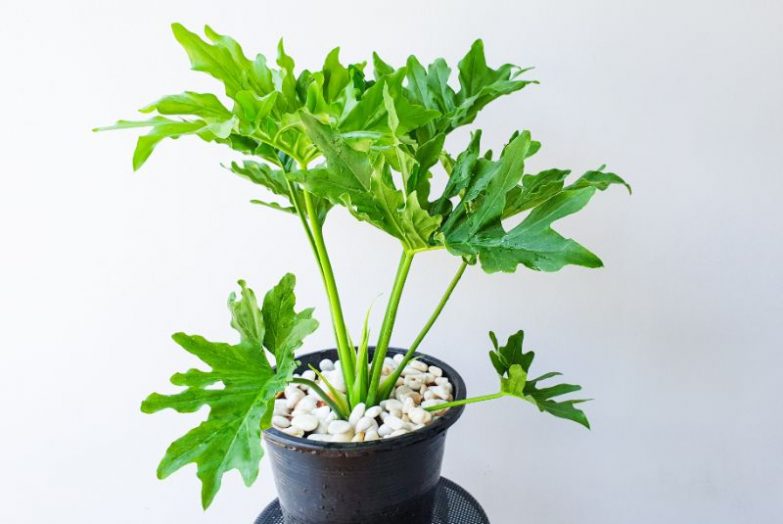Philodendron xanadu, recently renamed Thaumatophyllum xanadu, is a wonderful philodendron to grow as a houseplant. With spreading, upright growth, and deeply split leaves it’s great for adding a tropical vibe to your indoor space. In this article, we’ll explain everything you need to know about Philodendron xanadu care and help steer you away from the pitfalls.
Philodendron xanadu care requirements include moderate indirect light and well-draining soil that never dries out or remains soggy. Moderate to high humidity, temperatures of 65ºF (18ºC) to 85ºF (29ºC), and a little fertilizer every 2-4 weeks over the growing season will help your plant to thrive.
Philodendron Xanadu Overview
The expansive toothy, green foliage of Philodendron xanadu generates a tropical atmosphere whether grown as a houseplant or in a massed outdoor planting. It’s airy, upright growth remains contained and doesn’t require staking or other support.
Philodendron xanadu has a complicated background. It was granted a patent as an Australian cultivar in 1983 but was later discovered to be a wild species native to Brazil. In 2018, it was renamed Thaumatophyllum xanadu based on DNA evidence It may take the plant world a little while to catch up to the change, so let’s stick with the more widely used name for now: Philodendron xanadu.
This is a fairly easy-going rainforest dweller with large, low-spreading, lobed evergreen foliage that hangs from smooth, upright stems. It rarely flowers indoors.
A smaller relative of the ‘Selloum Hope,’ Philodendron xanadu forms into leafy clumps of up to three feet high by five feet wide. Its leaves can grow over a foot long even when grown in a container.
The plant becomes even more attractive with maturity, gaining darker green leaves, a thick trunk, and aerial roots along the soil surface.
Philodendron Xanadu Care Summary
| Scientific Name | Thaumatophyllum xanadu (Previously Philodendron xanadu) |
| Origin | Brazil |
| Light Requirements | Medium to bright, indirect light. Will scorch in direct sunlight. Does better than many houseplants in lower light. |
| Watering | Requires consistently moist soil. Water thoroughly once the top inch of soil dries out. Avoid letting the plant sit in soggy soil, as can be prone to root rot. |
| Soil | A light, open, well-draining potting mix is important. A mix of equal parts peat/coco coir, perlite, and compost is a good choice. |
| Temperature | Does best between 65ºF (18ºC) and 85ºF (29ºC). Try to keep the temperature above 55°F (13°C). |
| Fertilizer | Fertilize every 2-4 weeks during the growing season. A prefer to use a balanced, water-soluble fertilizer diluted to half the recommended dose. |
| Humidity | Moderate to high humidity levels. >40% ideally. |
| Flowering | Rarely blooms indoors |
| Pruning | Minimal pruning is required, other than to remove old or damaged foliage. |
| Propagation | Best propagated by division, but stem cuttings can also be propagated. |
| Re-Potting | Doesn’t require frequent repotting. Wait until the plant shows signs of becoming rootbound. |
| Diseases and Pests | Fairly pest resistant. Erwinia can be an issue, as can common pathogens causing root rot. |
| Toxicity | Toxic to humans and pets if ingested. Sap can also cause skin irritation. |
| Where To Buy | Buy Philodendron xanadu online at Etsy (I buy most of my houseplants from Etsy). |
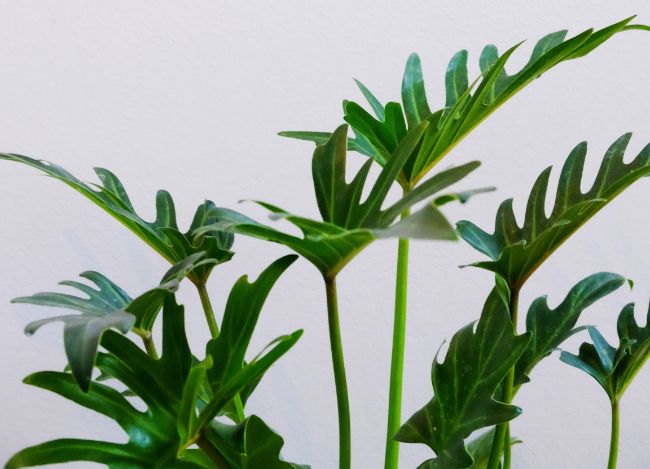
Philodendron Xanadu Light Requirements
Philodendron xanadu likes a good amount of indirect light, but it scorches easily in direct sun. The plant does best in a bright room where the rays never shine directly on its foliage.
A few hours of mild direct rays in the morning or early evening are well tolerated … but exposing the leaves to overly bright conditions can cause them to become discolored and pale even if they don’t burn.
The plant can cope with low light better than many tropicals. Its leaves tend to darken if the illumination is dim, but it will grow leggy if it starts to struggle in low light. It’s easy to overwater a Philodendron xanadu that’s kept in low-light conditions because it consumes less.
Read my article about light levels for houseplants to learn more about how to ensure your houseplants are getting perfect lighting.
How To Water Philodendron Xanadu
Watering is the trickiest part of Philodendron xanadu care. The plant likes consistently moist soil but cannot stand wet feet. And, though it’s prone to rot, it doesn’t like drying out, either.
You can’t water according to a set schedule: you’ll have to monitor the soil.
Water when the top inch of the medium has dried. It should take about a week for the soil to arrive at this point … if the soil doesn’t dry quickly enough, you may need to resort to lighter servings.
Note: This isn’t a great solution, but it’s better than encouraging root rot.
Here are other tips:
- Be aware that the plant’s water intake varies according to the season and the amount of light it’s getting. As a general rule, keep the soil moist during the growing season. Water more sparingly in the winter.
- If your plant is overpotted in a container too large for its root system, the soil can take longer to dry properly.
- Increasing light intensity may help the plant use water more quickly.
- It’s generally good practice to flush the soil with excess water so that it washes toxins from the mix. This isn’t a good idea if the soil is heavy and holding, however. (Upgrade the medium during your next repotting!)
- If necessary, limit flushing the soil to the warm growing months when the soil dries more quickly.
- Remember to empty filled cache pots after watering.
Philodendron Xanadu Soil Requirements
A fast-draining mix does two important things: it keeps the Philodendron xanadu’s roots from sitting in wet soil, and it maintains the oxygen they need. A light and open soil makes proper watering much easier.
The plant likes pH to be between 5.6 and 7.5, so it won’t mind peat or other organic materials that gradually acidify the soil as they break down. Philodendron xanadu’s native soil is made of organic matter and they do well in it, but the fertility and aeration quality of these materials degrade and must be replenished.
It’s a good idea to add inorganic aerating elements like pumice and perlite to the soil that don’t break down.
The following are good building blocks of a Philodendron xanadu’s soil mix:
- Peat moss
- Coconut coir
- Perlite
- Pumice
- Coarse sand
- Orchid bark
- Compost
One good recipe is to mix together peat moss or coco coir, perlite, and compost in a ratio of one-third each. Another inorganic amendment can be substituted for the perlite if desired. You can also add a modest amount of bark or wood chips. I’ve written a complete article about making and choosing houseplant soil, so check it out if you’d like to learn more.
Humidity
The Philodendron xanadu appreciates humidity, but it’s more tolerant of average levels than many rainforest tropicals.
Their growth will generally be more lush and glossy if there is more moisture in the air; keeping the soil consistently hydrated helps the plant adjust to drier conditions.
If your environment is extremely dry or wintertime heating has dropped humidity to the point the plant is struggling and showing dry, lackluster leaves, there are a few ways to increase humidity:
Grouping Plants – Put plants together so that their normal transpiration mutually increases local humidity. Avoid crowding to ensure good airflow and minimize the risk of spreading pests or disease.
Water Trays – Another way to modestly increase humidity is to place water-filled trays near the plants. To save space, you can add pebbles to the trays and place the plant’s container on top where it can sit safely above the waterline.
Room Humidifier – It’s probably not necessary, but you can go all-out and use a humidifier to recreate a virtual rainforest. There’s extra expense and maintenance involved, but it will solve the issue.
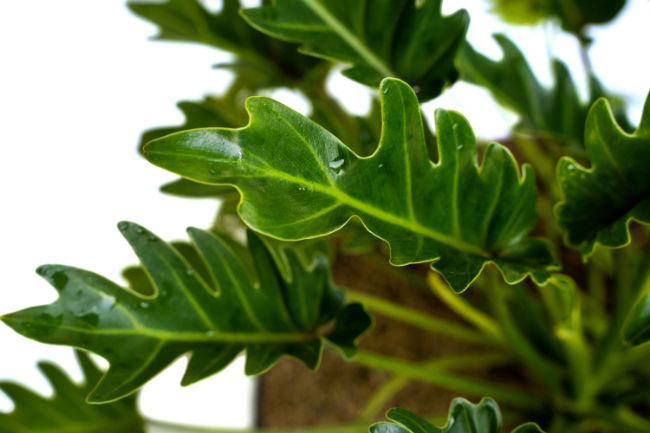
Temperature
Philodendron xanadu likes warm temperatures above 55°F (13°C) and does best between 65ºF (18ºC) and 85ºF (29ºC). The plant will die back in colder temperatures but may eventually recover as long as they don’t freeze.
The plant is sensitive to rapid temperature fluctuations and drafts. Keep them away from air conditioning or heating vents.
The plant survives outdoors year-round in USDA hardiness zones 10-11. Some growers in Zone 9 help the Xanadu survive as a landscape plant by protecting it with mulch and covering them during a frost.
How To Fertilize Philodendron Xanadu
Routine fertilization during the growing season is important for providing great Philodendron xanadu care … but be careful not to overdo it. Their roots are sensitive to burning: too little fertilization is better than too much.
Feed lightly in the spring and increase the amount as the weather heats up and the plant steps up its growth. Taper off in the autumn and stop fertilizing completely over the winter months.
There are three common fertilization methods:
- Use a balanced fertilizer diluted to half the label’s recommended dose; feed monthly in the spring and autumn, and every two weeks in the summer.
- Dilute the fertilizer to about a teaspoon per gallon and use it for watering.
- A slow-release formula can be sprinkled over the soil. This might not be a good option for pets or children who may be attracted to the colorful granules. One dose lasts from six months to a year, so apply in spring.
Here are tips for fertilizing Philodendron xanadu:
Always apply to damp soil.
- Your Xanadu can suffer from a buildup of fertilizers, which is another important reason not to overfeed. The residue can burn the roots and cause leaf discoloration and poor growth.
- Try to flush the soil at least monthly.
- Synthetic fertilizers work well, but organic fertilizers nurture the soil and are less likely to damage the plant.
- Read my guide to fertilizing houseplants for more information.
Rarely-seen Spathe Flowers
Keeping a Philodendron xanadu is about foliage, not flowers – it rarely blooms as a potted houseplant.
The plant has a spathe instead of a traditional flower. The bloom is a dark, purplish cover around an inner spadix spike composed of a myriad of tiny flowers.
Pruning
Philodendron xanadu naturally grows in a loose clump. You seldom need to prune them into shape.
You may, however, need to groom the plant by removing damaged or dying leaves. Older leaves yellow and die as part of their natural growth process and should be removed to eliminate a hiding place for pests or fungus.
Whether you use scissors or knife, sterilize the blades with isopropyl (rubbing alcohol) before use. Cut the stem cleanly at the base.
Another occasional pruning chore is cutting back a plant that’s become leggy and sparse in order to let thicker growth emerge. (Take steps to correct issues that led to the plant becoming spindly in the first place.)
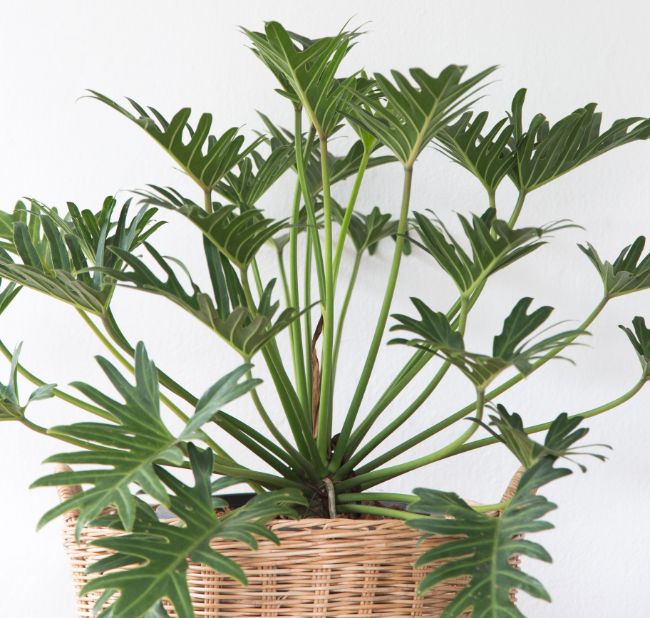
Repotting
Frequent repotting isn’t essential for good Philodendron xanadu care. Young plants typically benefit from an annual refit but can go longer if they aren’t ready.
Here are signs your Xanadu is ripe for repotting:
- The root system has filled the pot and roots are circling the bottom.
- The plant needs to be watered every two or three days.
- Growth has slowed.
- The soil isn’t draining as well as before.
To give the plant a headstart in its new quarters, repot in late winter or early spring before new leaves begin to emerge.
A Philodendron xanadu should be tightly potted so that there isn’t much empty soil that could stay too moist. A pot that’s two to three inches larger than their root ball is adequate.
You don’t need to tease out the old roots – they will find the fresh soil. Handle the plant carefully to avoid additional stress.
Read my guide to repotting rootbound houseplants to learn more.
Propagation Methods
The most practical ways to propagate your Philodendron xanadu are root division and stem cuttings. Since the plant is subject to rot, it’s critical to monitor the moisture level and give them warmth and strong indirect light. You want the plant to start growing immediately and not languish.
Division
The best time to divide the roots is during a repotting in the spring. It’s a good idea to thoroughly water the plant the day before to give the roots some resilience.
Here are the steps:
- Remove the plant from the pot and look for a natural separation point between “clumps.” Don’t reduce the plant to single stems, but keep them in groups for a fuller result.
- Gently separate the root ball into one or more sections by carefully pulling them apart. If the roots are too thickly entwined, you can cut them with a sterile blade.
- Repot each section into its own container. Use the same well-draining soil mix. Plant them at the same depth as before, covering the white part of the stems. Don’t bury them too deeply or they will rot.
- Water the plants to settle the mix around their roots. Be extra careful with watering as they recover.
Stem Cuttings
It’s more difficult to propagate your Philodendron xanadu from cuttings because they have so little resistance to moisture-related pathogens. Rot easily sets in.
- Cut a three- to six-inch portion from the tip of a young stem. Cut just above a leaf.
- Remove the lower leaves, keeping two or three at the top.
- Place the stem in water or directly in soil:
- If using water, change the water consistently to keep it as fresh as possible and help stave off decay pathogens. A daily change isn’t too much. Use water without chlorine or chloramine – purified water is best.
- Implanting the stem directly in (sterile) soil means the plant won’t have to adjust to a new medium after sprouting. To avoid further trauma to the cutting, don’t push it into soil: make a hole to place it in and gently tamp the soil around it. Moisten the medium and keep it slightly damp.
Pro Tip: Just before planting, dust the cuttings’ ends with cinnamon—a natural fungus fighter – or a similar commercial preparation.
- Give the new plants bright indirect light and keep them warm. Roots should appear in two to three weeks.
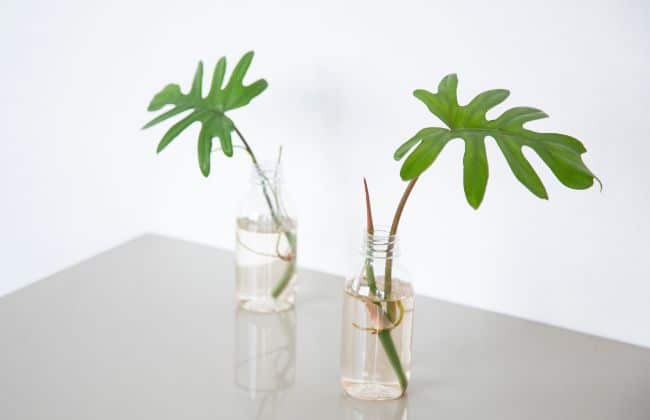
Philodendron Xanadu Care Tips
- It’s natural for older leaves to turn yellow and die. Don’t worry unless loss becomes excessive, new growth stops, or young leaves emerge with damage.
- Remember that the plant is prone to root rot. Factors like overly large pots, dim light, heavy soil, or cool temperatures can cause the mix to hold water too long and endanger the plant.
- If you move the plant to brighter light—often a good move—it’s wise to avoid shock by letting them acclimate.
- Clean the leaves regularly with a damp cloth to keep them shiny and dust-free. This hinders pests, too.
- If your soil drains well and it’s watering time, consider giving your Xanadu the treat of a warm shower or a short stay outside in a summer rain. This also helps curb spider mites. Be sure to let the pot drain well afterwards.
- Philodendron xanadu is an aroid and naturally has a lot of variation. Some leaves may be a bit different than others.
- Don’t expect aerial roots until the plant has reached maturity; similarly, don’t freak out if your Xanadu suddenly starts producing them.
Toxicity
The Philodendron xanadu contains calcium oxalate crystals that are poisonous to pets and people.
While not necessarily fatal, ingesting plant parts can cause burning, swelling and trouble breathing … consuming a large quantity can cause kidney failure. Even the sap can cause skin irritation.
Varieties
Philodendron xanadu was patented as an Australian cultivar from 1983 to 2002, when – oops – it was proven the plant is actually a natural Brazilian species. This was after the plant was named the Plant of the Year by Houseplants of Australia and had been given clever retail names such as Aussie and Winterbourn.
A few growers refuse to accept the plant isn’t an Australian-born designer hybrid. The patent has expired, however, and today the plant can be freely propagated without stepping on legal toes.
There is speculation that the plant’s small size is due to tissue culture methods used in large-scale reproduction. Other names for the plant are Excalibur, Showboat, and Millennium. Though it has many cousins (and names!), there is only one variety of Xanadu.
Pests And Diseases
The Philodendron xanadu care is relatively untroubled by pests – it’s not even appetizing to deer – so normal sanitation and inspection should keep trouble at bay. If you do encounter a random mealybug or scale infestation, horticultural oil and insecticidal soaps are gentle and effective treatments.
The plant doesn’t usually suffer from fungal problems, either … except for an annoying infection from the bacteria Erwinia. This nasty little bug is easily spread and produces an offensive odor as it liquefies your beloved foliage.
Erwinia often hitchhikes along with a new plant. Here are steps to limiting the infection:
- Quarantine new plants.
- Remove affect portions of the plant and discard them safely.
- Isolate the plant to prevent further contamination.
- Sterilize tools or soil that has touched the infected plant. The disease can be spread by hand contact or even from water splashing off an infected leaf.
- Give the recovering plant good air circulation (away from other plants) and monitor its progress closely.
- A healthy plant is the best preventative!
Last Word
Hopefully, this article helps you keep your Philodendron xanadu (Thaumatophyllum xanadu) in great shape. If you’re still having trouble with any particular aspect of Philodendron xanadu care or any of your other houseplants, check out the following resources.
- Causes of yellow leaves on houseplants.
- How to fix a wilting houseplant.
- What pots to use for indoor plants.
- Why do houseplant leaves turn brown?
- Guide to common houseplant diseases.
- How to identify, treat and prevent common houseplant pests.
- How to care for Philodendron Brasil.
- How to care for Heartleaf Philodendron
If you’d like to become an expert in caring for houseplants and be able to identify and fix problems easily, check out my book, Houseplants Made Easy. I cover everything you need to know to grow beautiful houseplants and keep them thriving with ease.

